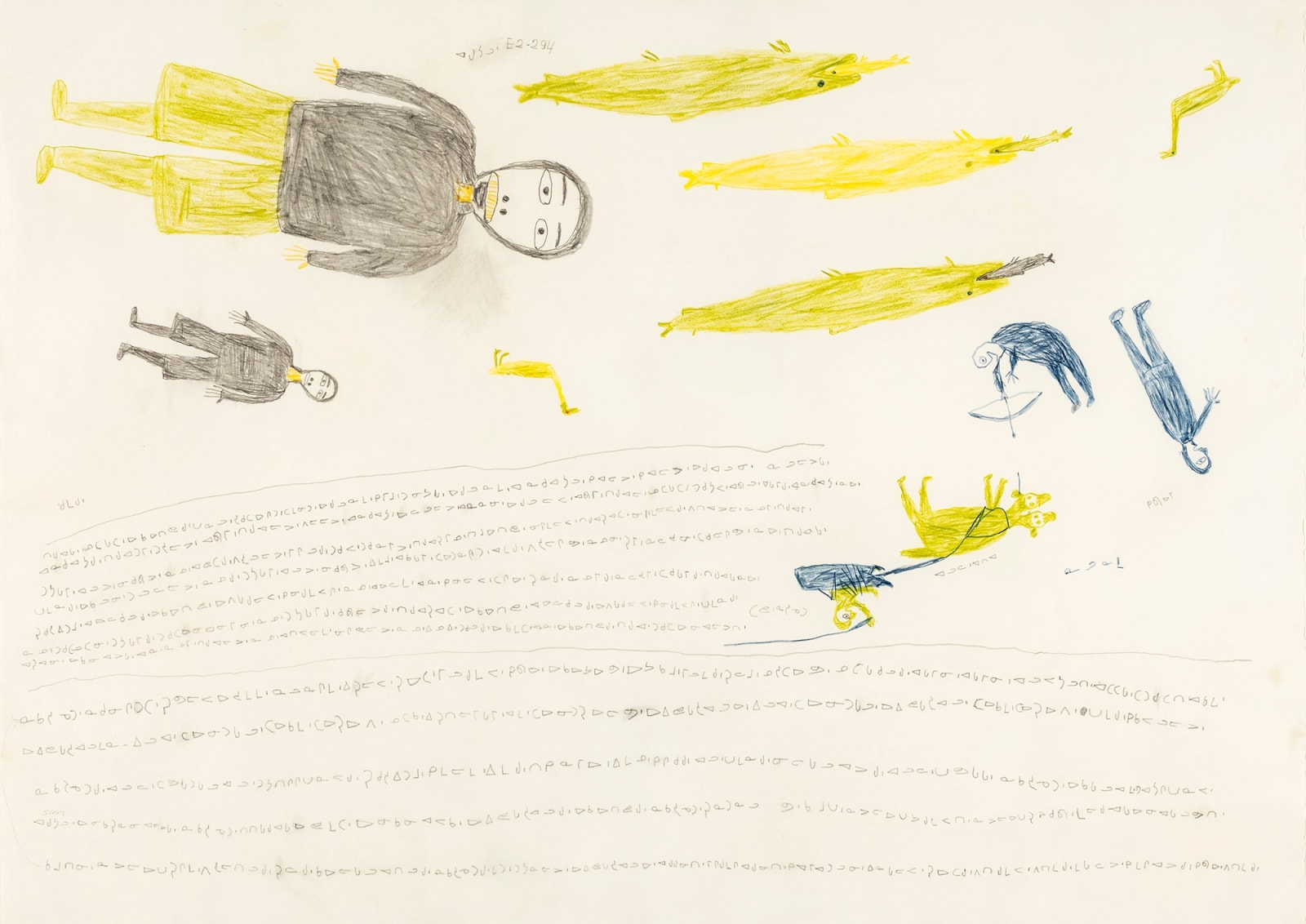-
Artworks
LUKE ANGUHADLUQ (1895-1982) QAMANI’TUAQ (BAKER LAKE)
Qiviuq, 1970coloured pencil on heavy wove paper, 29.25 x 41.25 in (74.3 x 104.8 cm)
extensively inscribed in graphite by the artist with didactic text in Inuktitut;
signed and inscribed with disc number, "ᐊᒍᓴᓗ E2-294".
LOT 36
ESTIMATE: $6,000 — $9,000
PRICE REALIZED: $8,400.00Most known for his depictions of traditional scenes of life on the land, in the present drawing, Anguhadluq departs from his usual subject matter to depict an episode of the...Most known for his depictions of traditional scenes of life on the land, in the present drawing, Anguhadluq departs from his usual subject matter to depict an episode of the Qiviuq story. Qiviuq, a legendary adventurer whose tales of heroism and narrow escapes from danger are well known though by most Inuit in Qamani’tuaq, is a subject seen serially throughout art produced in the community. In syllabics, Anguhadluq provides an extensive excerpt from the famous legend. In brief, it reads that a lone man arrives in an unknown village, where he is granted amnesty from cannibals by a woman in an igloo. The man flees from danger, escaping his would be captors by shooting the tracking dog, Alulla’q, in the ear.
The height of this dramatic tale — Qiviuq taking aim at the two-headed dog — is depicted at the centre right of the sheet, relatively small in comparison to the figures and fish elsewhere. Immediately beside this scene, we see the hero in profile, making his great escape. This imagery provided by Anguhadluq is composed without concern for the orientation of his didactic text. Jack Butler, the former Baker Lake arts advisor and the custodian of this work, described that this was due, in part, to the artist’s method of drawing. Anguhadluq, Butler explained, would work with his paper on the floor, rotating the sheet as he went [1]. However, this does not account for the artist’s variation of time, perspective, and spatial depth. Anguhadluq’s creative multiplicity of viewpoints rivals the dedication of European Cubist artists who consciously experimented with the ambiguities of representation in two dimensional works. The key difference, however, is that Anguhadluq’s aims come from an untutored, entirely intuitive place in the artist.
1. Marion Jackson, Baker Lake Inuit Drawings, 1985, p. 150.
References: For another segment of the Qiviuq story by Anguhadluq, see the serigraph print, Qiviuq Crossing the Ocean, 1975 #20. For the author's brief commentary on myth in Anguhadluq's art, see Jean Blodgett, Tuu'luq / Anguhadluq: An Exhibition of Works by Marion Tuu'luq and Luke Anguhadluq of Baker Lake, (Winnipeg: Winnipeg Art Gallery, 1976). The artist’s account closely follows Knud Rasmusseun’s 1931 report on the nakasungnaicut (those who have no calves); see Knud Rassmussen, The Netsilik Eskimos: Social Life and Spiritual Culture, Report of the Fifth Thule Expedition 1921-24, Vol. VIII, nos. 1 & 2, (Copenhagen: Gyldendalske Boghandel, 1931), p. 373-5. The reference recorded by Rasmussen is not identified as part of the Qiviuq legend, nor is the dog described with two heads (see also p. 301). For Rasmussen’s account of the Qiviuq stories, see p. 364-77 and 521-4, the latter, Rasmussen describes as the stories of Qiviuq that were “familiar to the Utkuhikjalikimut (Utkuhiksalingmiut). An episode of the hero’s story begins in a similar way: Qiviuq finds himself alone in a strange land, where he happens upon a group of cannibals and narrowly escapes certain death using his cunning and wits. Janet Kigusiuq depicts the nakasungnaicut in one of her coloured pencil drawings which is reproduced in Bernedette Driscoll, Inuit Myths, Legends, and Songs, (Winnipeg: Winnipeg Art Gallery, 1982), cat. 26, p. 40.
Provenance
Collection of Mr. Jack Butler, acquired directly from the artist.
Jack and Sheila Butler were arts advisors in Baker Lake in the crucial years of artistic flowering in the community from 1969 to 1976.Publications
K. J. Butler, “Remembering the Ancient Spirit Songs” in Keeveeok, Awake! Mamnguqsualuk and the Rebirth of Legend at Baker Lake, exh. cat., (Edmonton: University of Alberta, Ring House Gallery, 1986), p. 14, as “Kiviuq.”
Butler and Ruby Angrna’naaq provide a translation of the syllabics, pp. 16-18.
Cynthia Waye Cook, From the Centre: The Drawings of Luke Anguhadluq, (Toronto: Art Gallery of Ontario, 1993), fig. 11, p. 27.
Join our mailing list
* denotes required fields
We will process the personal data you have supplied in accordance with our privacy policy (available on request). You can unsubscribe or change your preferences at any time by clicking the link in our emails.




